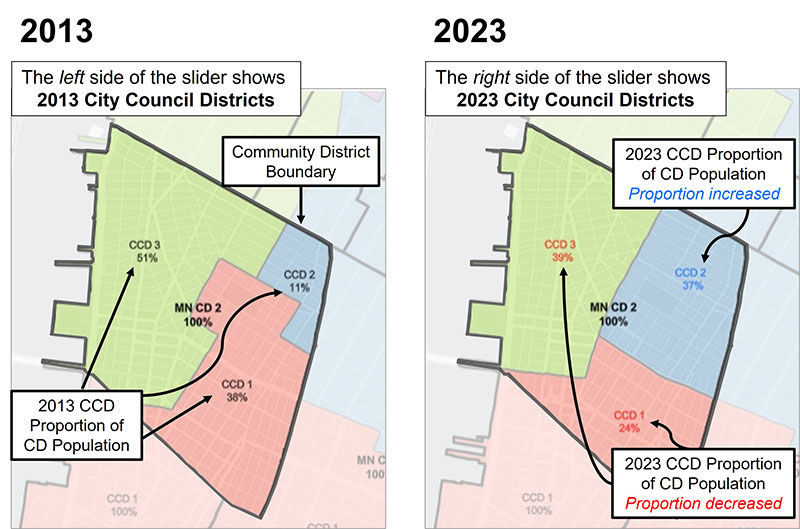
 Department of City Planning311
Department of City Planning311 Search all NYC.gov websites
Search all NYC.gov websites
Press Releases
For Immediate Release
September 7, 2023
Contacts:
Casey Berkovitz, Joe Marvilli – press@planning.nyc.gov (212) 720-3471
City Planning Releases Interactive Tool Exploring Community and City Council District Overlap following 2023 Redistricting
NEW YORK – Department of City Planning (DCP) Director Dan Garodnick today announced the release of a new interactive tool showing how the proportion of each community district in each City Council district changed following the 2023 redistricting of the New York City Council. This tool marks the first time that the data, which DCP is charged in the City Charter with determining after each City Council redistricting cycle, is being made publicly available in this format. It can be accessed here.
“DCP’s new interactive tool pulls back the curtain on the relationship between City Council and Community Board Districts, which has changed through redistricting,” said Dan Garodnick, Director of the Department of City Planning. “Democratizing wonky data like this is a core part of DCP’s work and I hope New Yorkers will find this tool useful.”

New York City is made up of 51 City Council districts, the borders of which change each decade following the decennial census, and 59 Community Districts, which are represented by Community Boards and whose borders change less frequently (and remain essentially unchanged since 1975). Because the borders of these two districts do not directly match and are not static, DCP determines the proportion of each Community District’s population that is represented by each council member following every redistricting. This proportion is most prominently applicable because Council Members nominate a number of community board members based on the rough proportion of the Community District that they represent.
The largest shifts in Community Districts between 2013 and 2023 City Council Districts include:
- Brooklyn Community District 10 (Bay Ridge, Dyker Heights, Fort Hamilton) saw the largest swing in its distribution, with Council District 43 decreasing from 91% of the Community District’s population in 2013 to 11% in 2023.
- Queens Community District 6 (Forest Hills, Forest Hills Gardens, Rego Park), which was 99% in Council District 29 under the 2013 districts, retains a majority of its population in Council District 29, but also has significant new representation in Council District 30 and a new presence in Council District 24.
- Bronx Community District 6 (Bathgate, Belmont, Bronx Park South, East Tremont, West Farms) is entirely represented by Council District 15 in 2023, a change from 2013 when the population was distributed between Council District 15 and Council District 17.
“Good governance means addressing the needs of constituents in Community Districts through representation by members of the New York City Council. That is not a one-to-one relationship in many cases, with Community Districts sometimes represented by multiple members of the City Council. By showing changes in how Community Districts are juxtaposed with Council Districts, local constituents can better understand how their needs are being represented by members of the City Council,” said Joe Salvo, Institute Fellow at the Biocomplexity Institute and Initiative at the University of Virginia and former New York City Chief Demographer.
“Another brilliant data visualization by the DCP Population Division showing the how the new city council districts map onto the community boards and who will have the appointing powers for them,” said John Mollenkopf, Director of the Center for Urban Research at the CUNY Graduate Center.
Department of City Planning
The Department of City Planning (DCP) plans for the strategic growth and development of the City through ground-up planning with communities, the development of land use policies and zoning regulations applicable citywide, and its contribution to the preparation of the City’s 10-year Capital Strategy. DCP promotes housing production and affordability, fosters economic development and coordinated investments in infrastructure and services, and supports resilient, sustainable communities across the five boroughs for a more equitable New York City.
In addition, DCP supports the City Planning Commission in its annual review of approximately 450 land use applications for a variety of discretionary approvals. The Department also assists both government agencies and the public by advising on strategic and capital planning and providing policy analysis, technical assistance and data relating to housing, transportation, community facilities, demography, zoning, urban design, waterfront areas and public open space.


